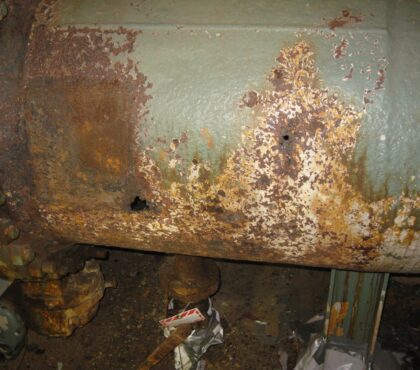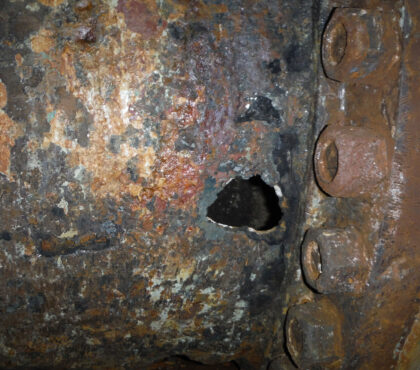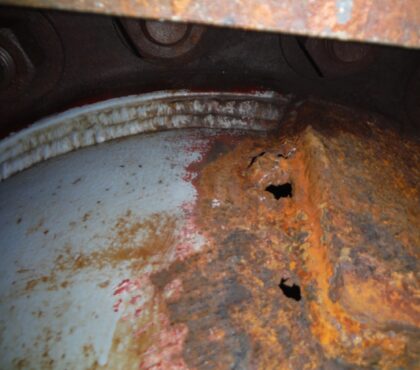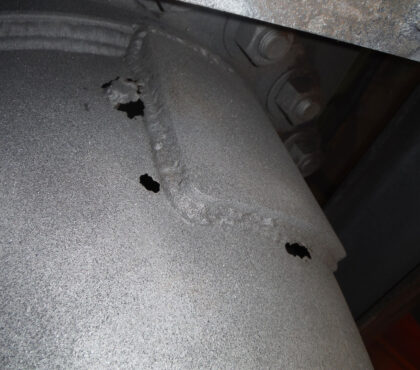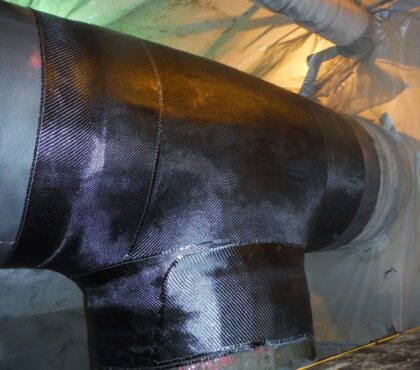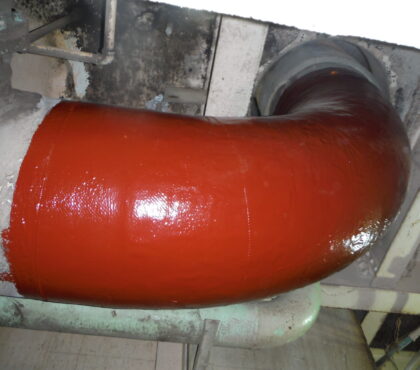Background
A thermal power generating plant located in the Northeast United States suffered a costly and disruptive forced shutdown due to the flooding in the plant’s main steam condenser area, situated in the basement of the plant. Given the significant economic consequences of an unplanned outage to the utility that owns the plant, an internal investigation was commissioned to determine if the flooding was a unique occurrence or as a result of a deeper underlying problem, and to ensure further forced shutdowns were prevented.
Immediate Challenge
The internal investigation traced the flooding to a through-wall failure in the circulating water line that supplied cooling water to the main steam condenser. At 30 inches in diameter, this pipeline provided 250,000 gallons of cool, saltwater to the plant’s main steam condenser. The first solution considered by the plant was to install a pipe clamp to mechanically seal the leak and provide a temporary repair that would allow the plant to return to operation until the next planned outage. This is a standard repair method and one that is relatively easy to install on small and medium diameter pipes. Unfortunately, the maintenance staff found that the size of the pipe presented a challenge, as pipe clamps of the needed size were not readily available in the region the plant was located. Also, pipe clamps are only effective on straight sections of pipe without supports or other interruptions.
Alternative metallic repair methods required welding of custom-made sections onto the existing pipe. A traditional fiberglass pipe repair system only offered a temporary repair on pipes with through-wall failures. The plant desired a long-term, maintenance-free solution that was compliant with ASME PCC-2 Article 4.1, Non-Metallic, Composite Repair Systems: High-Risk Applications.
Pipeline Failure Analysis
Once the immediate problem was solved, the team went back to look at the causes of the failure. They discovered that the most likely culprit was a combination of internal and external corrosion on the circulating water lines. The lines were over 30 years old, made of carbon steel, and carrying highly-corrosive saltwater. The internal coating system on the pipes was well past its expected service life. Further, previously completed weld repairs destroyed the internal coating systems on the pipes, creating additional areas of extreme corrosion adjacent to the repaired sections. Altogether, the extent of the corrosion overwhelmed the cathodic protection system, as well. Cathodic protection is designed as a secondary means of corrosion prevention that operates in conjunction with a barrier coating. Existing widespread coating failures rendered it unable to protect the underlying substrate.
Having determined that this failure was not a unique occurrence, but a symptom of widespread corrosion throughout the entirety of the circulating water lines, the plant employed a ranking system on this critical asset to determine the areas most likely to experience future failure. The ranking was determined through visual inspections of welded repairs, external corrosion, etc. and extensive ultrasonic thickness testing of the pipeline. Several areas were identified as highly likely to experience future failure and required attention at the next planned outage.
Advanced FRP Systems’ Solution – Systemic Repair
As with any facility, budgetary restrictions did not permit a repair of the entire pipeline in a single, or even three or four planned outages. Instead, using the same composite repair technology from Advanced FRP Systems employed on the emergency pipe repair, the plant has been able to slowly upgrade their circulating water line, prioritizing critical areas at each planned outage. The key to this staged repair has been the implementation of thorough inspection and testing into the ranking system. This has enabled the plant management to budget a fixed sum for repairs during each planned outage and continually repair and rebuild the entire circulating water line.
This approach has ensured the avoidance of further forced shutdowns and supported an improvement program to strengthen the power plant infrastructure, contributing to the continued operation and commercial success of the facility.
Having Issues with Pipe Corrosion or Erosion?
Contact us for a free evaluation!
X

